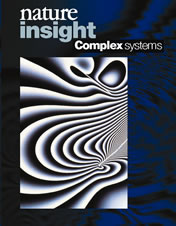Complex systems
Vol.
410, No. 6825 (8 March 2001).
|![]() PDF
PDF![]() (207
(207![]() K)
K)![]() |
|
 |
Cover
illustration |
The science of complexity, as befits its name, lacks a simple definition. It has been used to refer to the study of systems that operate at the 'edge of chaos' (itself a loosely defined concept); to infer structure in the complex properties of systems that are intermediate between perfect order and perfect disorder; or even as a simple restatement of the cliché that the behaviour of some systems as a whole can be more than the sum of their parts.
Notwithstanding these difficulties over formal definition, the study of complex systems has seen tremendous growth. Numerous research programmes, institutes and scientific journals have been established under this banner. And the new concepts emerging from these studies are now influencing disciplines as disparate as astronomy and biology, physics and finance. The richness of the field and the diversity of its application lends itself naturally to the Insight format, although our choice of themes to review is necessarily somewhat eclectic.
For the first two articles, we consider systems in which the microscopic properties can be immensely complex or poorly constrained, but which on larger scales exhibit behaviour that seems insensitive to mechanistic details. We then shift our focus to systems where both the properties of the individual components and the nature of their interactions are reasonably well understood, yet the collective behaviour of the ensemble can still defy simple explanation. Finally, we consider the many complex rhythms encountered in living organisms. Decoding the essential features of these rhythms might ultimately be of benefit to medicine, even in the absence of a simple mathematical interpretation.
As should be clear from these articles, the science of complexity is in its infancy, and some research directions that today seem fruitful might eventually prove to be academic cul-de-sacs. Nevertheless, it seems reasonable to suppose that the general principles emerging from these studies will help us to better understand the complex world around us.
Karl Ziemelis Physical Sciences Editor
| Crackling
noise JAMES P. SETHNA, KARIN A. DAHMEN & CHRISTOPHER R. MYERS
| 242 | ||
| Noise
to order TROY SHINBROT AND FERNANDO J. MUZZIO
| 251 | ||
| Supercooled
liquids and the glass transition PABLO G. DEBENEDETTI AND FRANK H. STILLINGER
| 259 | ||
| Exploring
complex networks STEVEN H. STROGATZ
| 268 | ||
| Synchronization
and rhythmic processes in physiology LEON GLASS
| 277 | ||
